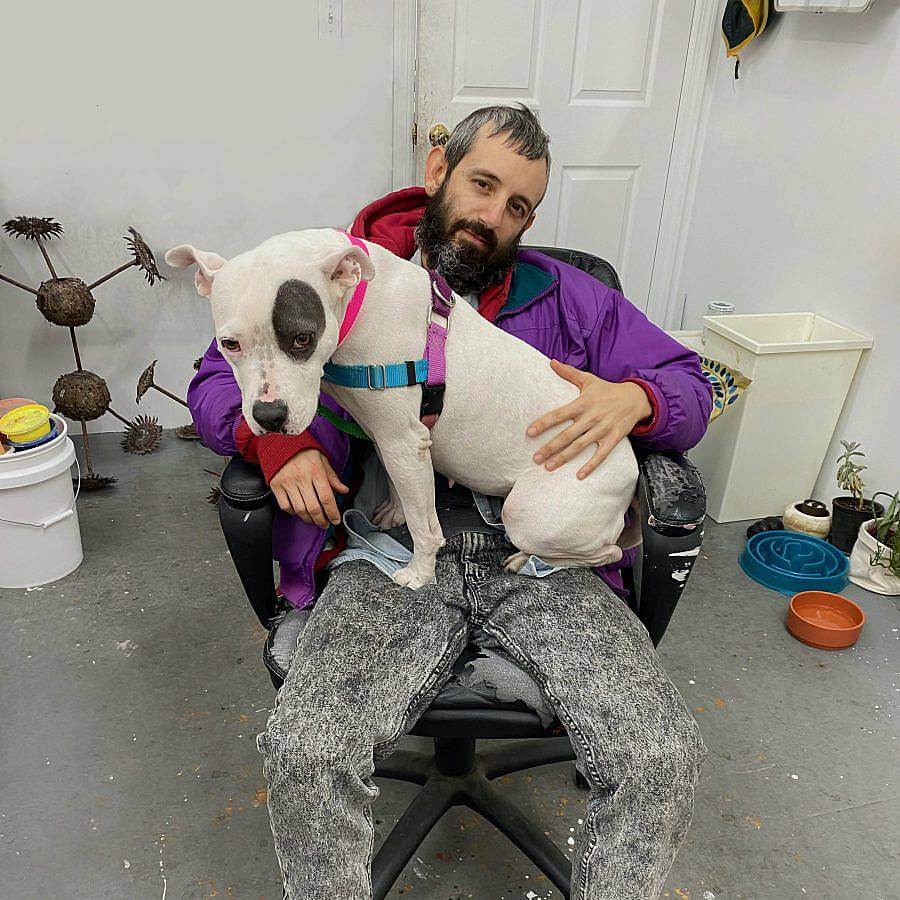What catalyzed your interest in art?
For high school, I went to Pinellas County Center for the Arts, a public “magnet school” in St. Petersburg, Florida. Around those same years I spent a lot of time at Youth Arts Corps, a free after-school art program located in the south side of St. Petersburg – a non-profit that was started by my mother, Mary Ann Nunziata Assiff. After so much immersion in visual arts, I attempted to veer off the artist path by going to community college with the idea of studying cultural anthropology, but eventually art school came for me (RISD) and I have been a practicing artist since.
How do you describe your practice?
These days, I am primarily a painter. Over the past 10+ years, I have developed a process of making low-relief plastic paintings, a process using methacrylic plastic, modified squeeze bottles and poured liquid latex. I’ve applied this low-relief process onto surfaces such as space heaters, refrigerators, rat poison bait stations, bicycle tire treads and electrical conduit, among others.
Besides painting and other assorted sculptural processes, such as wood carving and repoussé, I would say a unique part of my practice is misdirection. For example, I have forged LEED environmental certification of exhibitions, bought phony carbon credits for exhibitions, embarked on sham lead pipe remediation of the exhibition space and exhibited bootlegged organic produce from a fictitious island nation. This strategic lie-placing is mainly in service of an ongoing critique of neoliberal environmental schemes and contemporary notions of Ecology. I use Ecology as a lens to view a myriad of themes: climate change-induced war and migration, colonialism and environmental racism, extractivism, brownfields and bioremediation, animal agriculture and attitudes toward non-human nature, the imaginary of doomsday survivalism, etc.
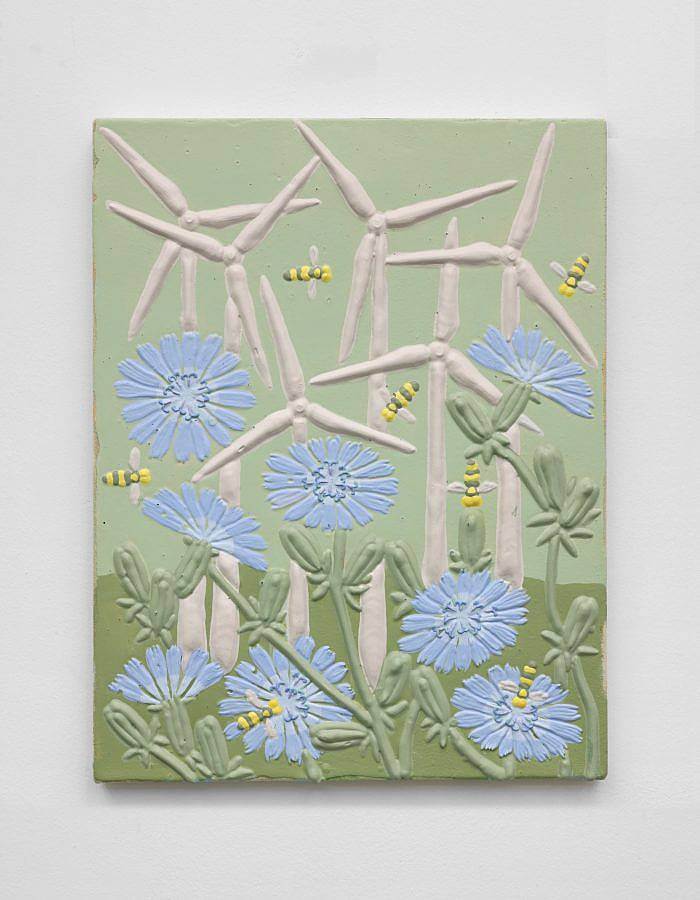
What are the overarching motifs in the art you make?
In my last series, I explored the world of weeds throughout New York City and, in particular, this cemetery in Queens that had re-entered a wilded state, due to the corruption of a father and son NYPD cop duo at the helm of the cemetery’s board of directors. I regularly took long expeditions into this ecological zone and found myself acting as an amateur botanist/naturalist – identifying, drawing and painting the weeds while foraging and making essential oils out of them, using a doomsday prepper-style distillation device that I made out of an old pressure cooker. My paintings from this time were composed solely of weeds and bugs, but I think New York City was tangible within the voids between the insects and weeds. On a metaphorical level, I was thinking of the weeds as a de-growth force in opposition to real estate development.
In the current work, I expanded my sample size from the ecology of NYC to the rest of the United States via its supply chains. I have been going on research trips with a long haul trucker, living in the trucker’s cab and photographing, videoing and drawing the weeds I encounter along the trucking routes. In addition to the special attention paid to the weeds across the US, the built infrastructure and human trash has become a player in my work. I am trying to syncretize an American landscape painting, with the flexed might of its military industrial agricultural core, along with the necrotic flesh of choked private property, confounding land use and trashed pollutionscapes (sic.).
What do you want a viewer to walk away with after seeing your work?
I think about the tone of an artwork a lot. I think attitude or affect is the most communicable element in contemporary art. I still attempt to pressure-fit an artwork with conceptual information, but I suppose, above all, I strive to leave the viewer with some sensation of smirking awe. I am chasing a certain flavor of banal sublime. I like to have the viewer sense the presence of ideology, but not readily discernible to what end. I think the way I have hidden my hand from the construction of my artwork gives an uncanny effect, a manufactured feeling surface fetish. I’ve used press releases to different ends, sometimes as space for a political screed, sometimes as a poetic piece of concrete comedy, sometimes opting out of having a press release altogether.
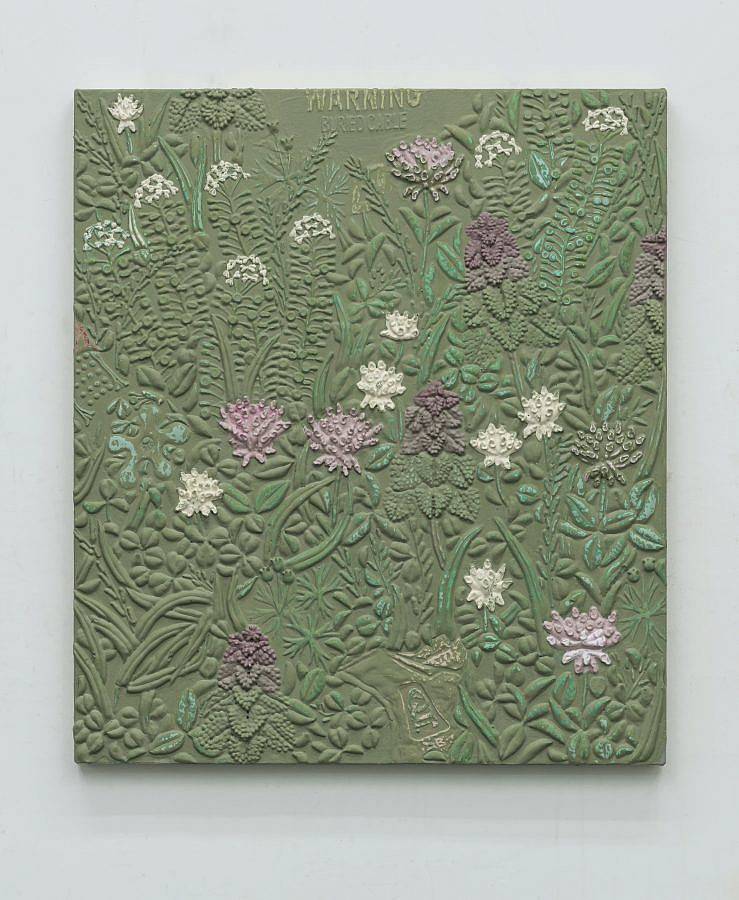
Who are some of your favorite artists?
Lately, I have been interested in the art that came out of the Cultural Revolution in China. Traditional ways of depicting sublime nature got retrofitted to exalt the power of the industrializing Communist state. Painting and ceramics that had been adorned with cliffs and craggy trees now were to contain dams, mines and batteries along with plenty of red flags. I love how the artists’ hand, trained to catch the wild movements of nature, handled this new inert industrial subject matter.
I must also (always) mention Henri Rousseau, who has been a muse of mine for over a decade now. His jungle paintings made in Paris during the late industrial revolution have a plastic, factory-like logic – leaves and flowers fitting together like cogs and gears. His work, created in the Parisian metropole during and after the French imperial adventures into Mexico, offer a unique window into modern European colonialist mindset.
Recently, a friend turned me on to Alexandre Hogue, whose ‘30s and ‘40s work has been blowing my mind. Considered by some to be the first American “eco-critical” artist, he set a path apart from the regionalist painters that were employed by the Works Progress Administration and painted the destruction of Midwest farmlands during the dust bowl, explicitly showing that the modern tools of farming were the cause of the drought and depletion of the soil. His painting style has so much volume and solidity, I definitely recommend checking him out.
Describe your current studio or workspace.
My studio is located in a former tuxedo rental company in Ridgewood, New York. My space is around 320 square feet, private and has a skylight. The studio is located on an EPA cleanup site. The dry cleaning chemicals that the business stored in buried tanks leached into the soil. There are EPA sensors that allegedly monitor chemical vapors. Apparently, the first symptom of exposure to these chemicals (trichloroethene [TCE] and tetrachloroethene [PCE]) is loss of color vision which wigs me out. After hours of working on my monochrome paintings, the cones in my eyeballs will fatigue and I start to see things in grayscale… which is what would happen if I were to be being poisoned!
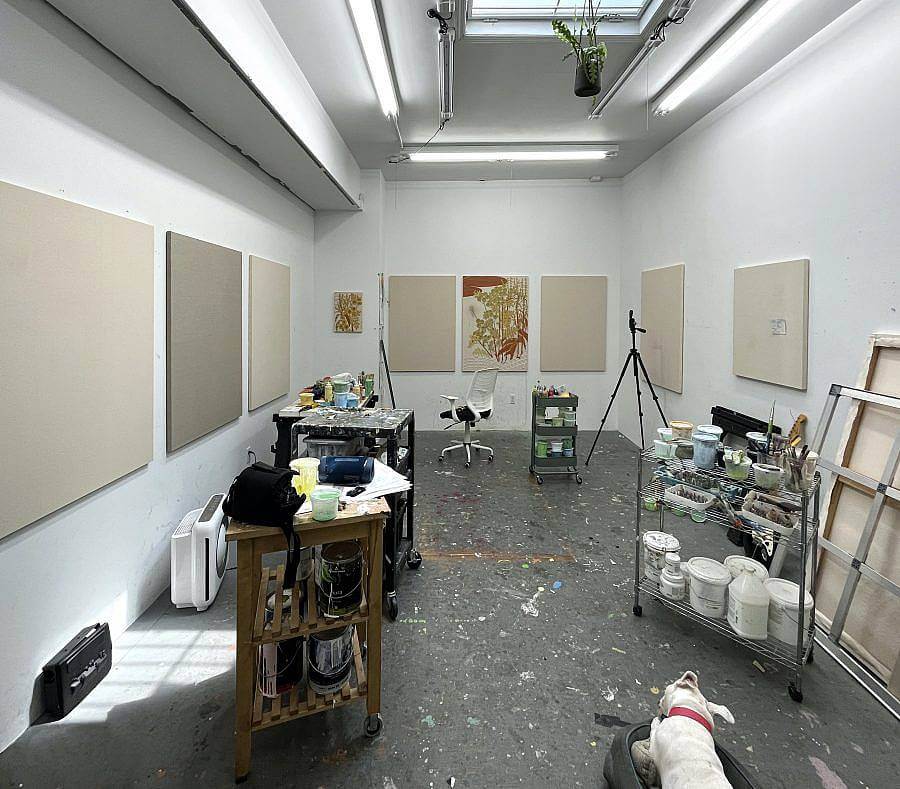
What is one of the bigger challenges you struggle with as an artist? How do you cope and how does it inform your practice?
Being an artist can be crazy lonely, spending long, lone hours in a studio facing an object on a wall. It accrues a social inertia, making it hard to enter social world after ages spent alone. Unlike other art forms, the default mode of contemporary art is anti-collaborative, engendering competition if left to its own devices. Even though I don’t do it as much as I should, studio visits are a heartwarming remedy. Come to my studio!
What excites you about being an artist?
Getting out of the studio and doing field work has been the most exciting part of my practice. The amateur botany of my last body of work and the research trips of my current work allow me to float around the country being an Invisible Eyeball as the transcendentalists would say, or being in an extended optimized non-linear flow state, as the Hubermen of today would say. Also, I am working on a documentary with and about the trucker that I have been taking research trips with, which has funny, collaborative elements to it.
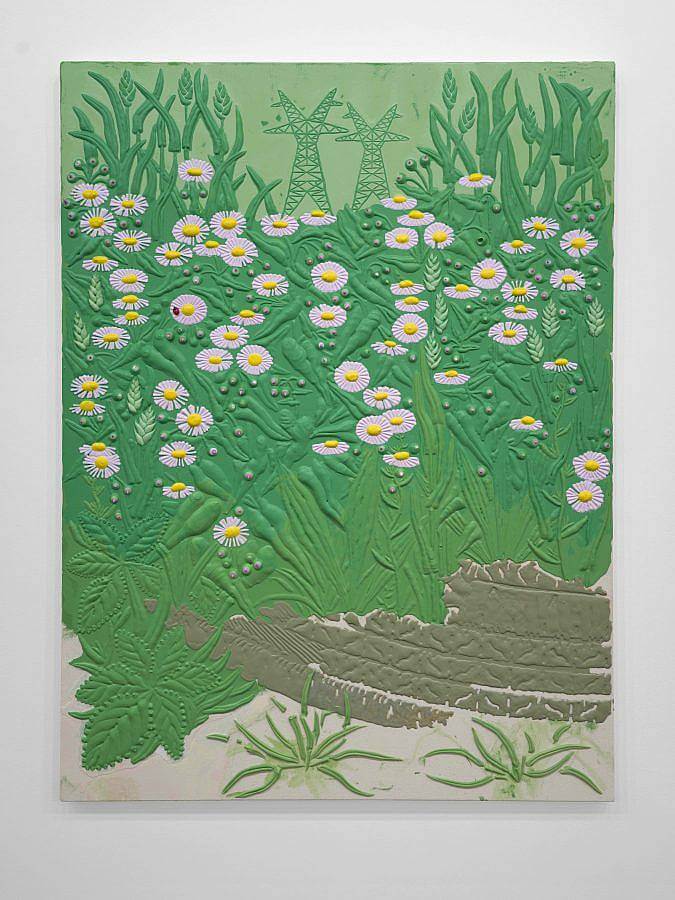
Any recent, upcoming, or current projects you are working on?
I am developing concrete low-relief paintings to be installed outdoors. I’ve been looking at WPA public artworks and wanting to operate on that New Deal frequency. Also, getting back into sculpture and installation work after a long foray into painting.
What have you been reading and listening to recently?
Stoner by John Williams; Lives of Weeds by John Cardina, The Mushroom at the End of the World by Anna Tsing. For music, a lot of NTS radio these days, recent Spotify activity includes: Wipers, Sun City Girls, Weather Report, Stars of the Lid, Frank Zappa, Muslim Gauze and Omar S. For podcasts, The Dig, True Anon, Behind the News with Doug Henwood, American Prestige, Electronic Intifada, and Democracy Now!
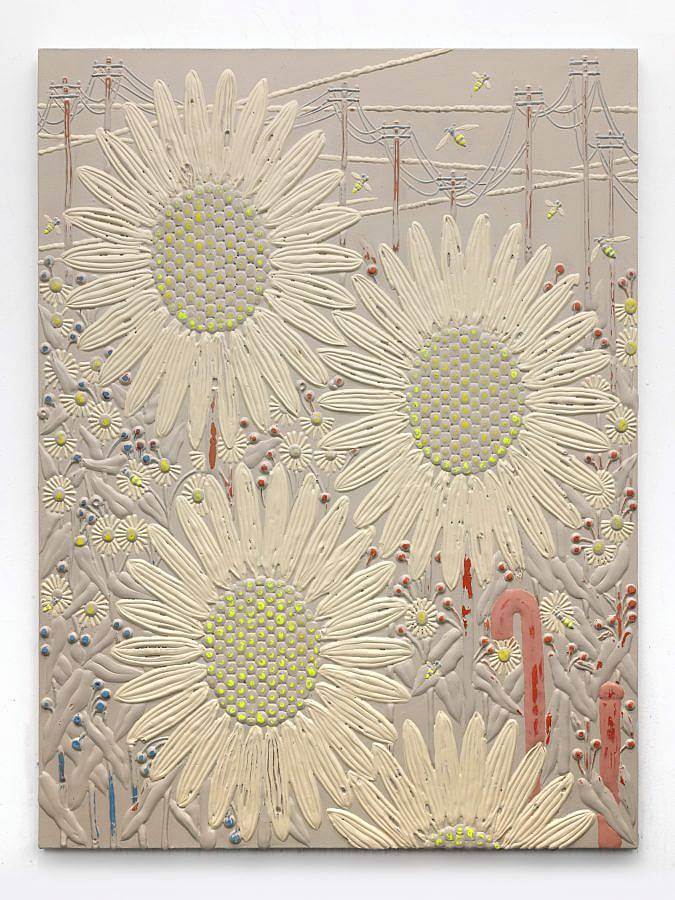
What’s your hottest take/most controversial opinion?
Evidently, supporting a free Palestine seems to be a controversial opinion within the art world, at least among the collector class and their institutional lackeys. I haven’t had much illusion about any sort of deeply-held, radically progressive political beliefs within the art world but the McCarthyist backlash to even the most anodyne humanitarian statements has been pretty astounding. It is worth noting that it’s kind of a funny time for these Zionist collectors to try to blacklist and economically punish artists and art workers. I don’t know whether its the interest rates or the election year effect, but according to most market accounts of blue chip and secondary market sales, they weren’t buying much to begin with! I say, whenever they do feel like opening their purse strings I hope they find some nice Israeli NFTs to put their assets into instead.
Favorite quotes/mantras?
I’ve had a Vladimir Lenin quote on my studio door for the last year and a half: “There are decades where nothing happens and weeks where decades happen.” The meaning of this quote has changed dramatically over that time and, geopolitically speaking, fully for the worse.
What do you collect?
I collect treasures on the sidewalk during my dog walks – the sort of human trash that crows like to collect and gift. Some examples include: die-cut suede butterfly wings, a plastic action figure arm grabbing a translucent lavender portal/web, a plastic caucasian princess with a notch missing where brain/hair should be, a ceramic decapitated goose head, a white acrylic model chapel, a rubber Baby Coyote Croc pendant, a cast glass angel affixed to shard of mirror, and a gold-chromed Timberland tree decal.
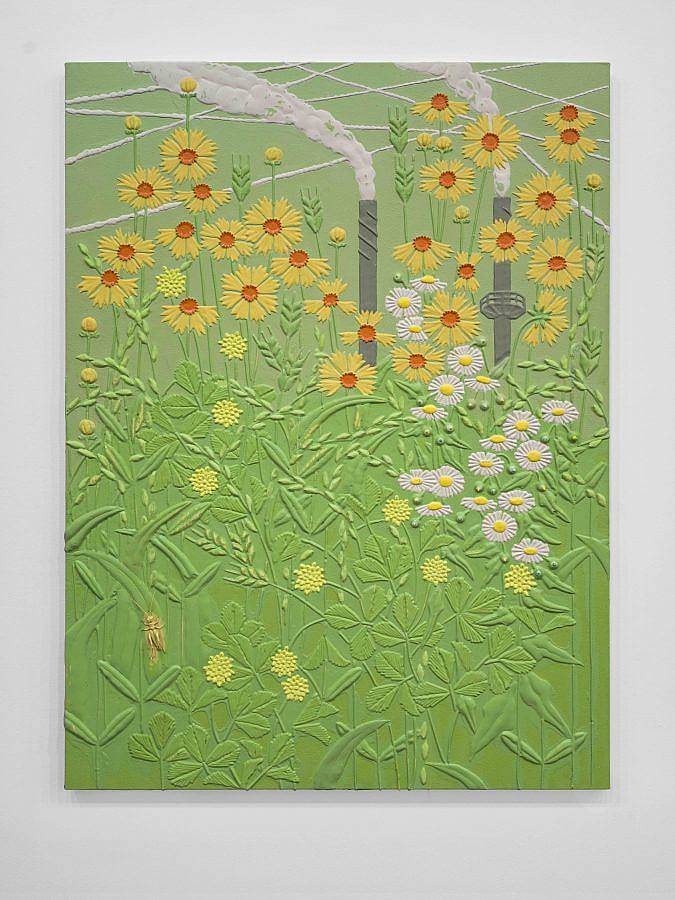
Interview conducted and edited by Natalie Toth. All images courtesy of the artist.
